Spatial Spillover Effects of Smallholder Households’ Adoption Behaviour of Soil Management Practices Among Push–Pull Farmers in Rwanda
Abstract
1. Introduction
2. Materials and Methods
2.1. Study Site and Data Collection
2.2. Methodology
3. Results and Discussion
3.1. Description of the Data
3.2. Spatial Correlation Test Results
3.3. Descriptive Statistics
3.4. Model Estimation
3.5. Direct, Indirect and Total Effects Results
4. Conclusions
Author Contributions
Funding
Institutional Review Board Statement
Informed Consent Statement
Data Availability Statement
Acknowledgments
Conflicts of Interest
Appendix A
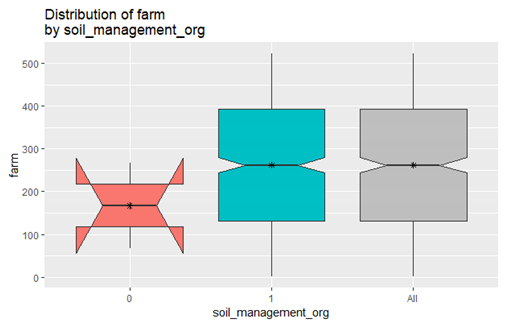
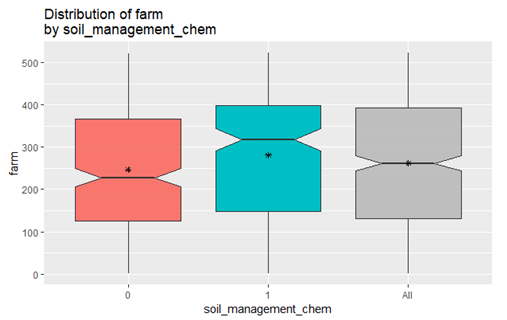
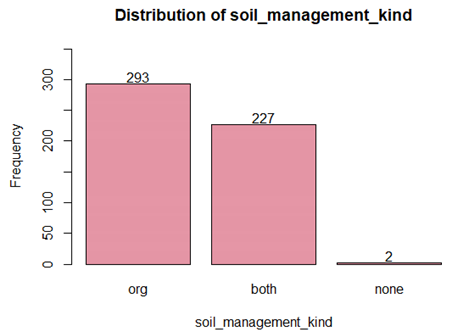
| Practice | Farms | Farms (%)(×/520) |
| Grasstrips | 238 | 45.76923 |
| Terrace | 291 | 55.96154 |
| Zero Tillage (zero_tilla) | 1 | 0.1923077 |
| Soil_bunds | 33 | 6.346154 |
| Trees | 223 | 42.88462 |
| Manure | 471 | 90.57692 |
| Compost | 200 | 38.46154 |
| Insecticide | 137 | 26.34615 |
| Herbicide | 13 | 2.5 |
| Urea | 186 | 35.76923 |
| Dap | 186 | 35.76923 |
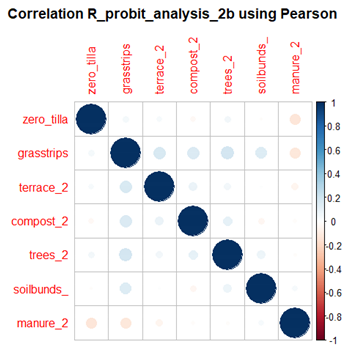

- SDPM model
- Explanatory Variables
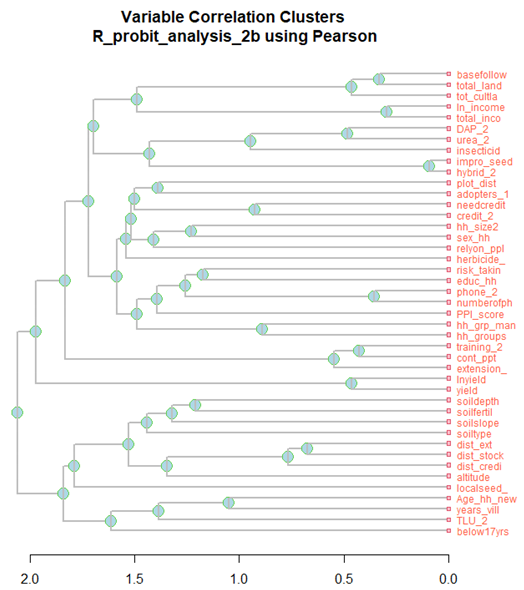
- Results
- Residuals:
| Min | 1Q | Median | 3Q | Max |
| −1.048334 | −0.060616 | 0.091822 | 0.197667 | 0.564332 |
- Type: mixed
- Coefficients: (asymptotic standard errors)
| Estimate | Std. Error | z Value | Pr(>|z|) | |
| (Intercept) | −0.215278788 | 0.635492186 | −0.3388 | 0.7347912 |
| Age_hh_new | 0.000627749 | 0.001374961 | 0.4566 | 0.647989 |
| TLU_2 | −0.016138459 | 0.012667918 | −1.274 | 0.2026765 |
| soilfertil | −0.001841891 | 0.023687025 | −0.0778 | 0.9380194 |
| plot_dist | 0.001176989 | 0.000863812 | 1.3626 | 0.1730238 |
| dist_ext | −0.000477514 | 0.000359487 | −1.3283 | 0.1840721 |
| altitude | 0.000020696 | 0.000089615 | 0.2309 | 0.8173606 |
| localseed_ | 0.105047275 | 0.04723567 | 2.2239 | 0.0261554 |
| lnyield | 0.034224434 | 0.01183739 | 2.8912 | 0.0038376 |
| total_land | −0.035387994 | 0.012352302 | −2.8649 | 0.0041715 |
| tot_cultla | 0.096609213 | 0.027424862 | 3.5227 | 0.0004272 |
| ln_income | −0.045048078 | 0.017904399 | −2.516 | 0.0118684 |
| DAP_2 | 0.05502942 | 0.037757077 | 1.4575 | 0.1449895 |
| insecticide | −0.103542282 | 0.039494583 | −2.6217 | 0.0087497 |
| hybrid_2 | 0.129887584 | 0.048795611 | 2.6619 | 0.0077708 |
| hh_size2 | 0.013360496 | 0.00718064 | 1.8606 | 0.0627968 |
| credit_2 | −0.049515727 | 0.037017275 | −1.3376 | 0.1810143 |
| educ_hh | 0.007490759 | 0.005646086 | 1.3267 | 0.1846022 |
| numberofph | 0.003798731 | 0.003574395 | 1.0628 | 0.2878899 |
| herbicide_ | 0.141911372 | 0.098880744 | 1.4352 | 0.1512367 |
| hh_groups | 0.119269054 | 0.051054309 | 2.3361 | 0.0194849 |
| training_2 | −0.025893669 | 0.052575736 | −0.4925 | 0.6223643 |
| extension_ | 0.03837975 | 0.050089043 | 0.7662 | 0.4435392 |
| lag.Age_hh_new | 0.004116688 | 0.003118104 | 1.3203 | 0.1867504 |
| lag.TLU_2 | −0.02027766 | 0.027766585 | −0.7303 | 0.4652129 |
| lag.soilfertil | 0.09126657 | 0.054305244 | 1.6806 | 0.0928364 |
| lag.plot_dist | 0.0052646 | 0.001801632 | 2.9221 | 0.0034765 |
| lag.dist_ext | −0.000926809 | 0.000679809 | −1.3633 | 0.1727765 |
| lag.altitude | −0.000068988 | 0.000192774 | −0.3579 | 0.7204403 |
| lag.localseed_ | 0.023964562 | 0.094437178 | 0.2538 | 0.7996795 |
| lag.lnyield | 0.035908368 | 0.024230838 | 1.4819 | 0.1383593 |
| lag.total_land | 0.006020113 | 0.025312409 | 0.2378 | 0.812011 |
| lag.tot_cultla | 0.006636944 | 0.052235674 | 0.1271 | 0.8988947 |
| lag.ln_income | 0.015046131 | 0.040842115 | 0.3684 | 0.7125769 |
| lag.DAP_2 | −0.051974991 | 0.083031446 | −0.626 | 0.5313362 |
| lag.insecticid | −0.141378619 | 0.083269934 | −1.6978 | 0.0895389 |
| lag.hybrid_2 | −0.075472321 | 0.10116769 | −0.746 | 0.4556601 |
| lag.hh_size2 | 0.012031846 | 0.016998507 | 0.7078 | 0.4790584 |
| lag.credit_2 | −0.121360029 | 0.083361088 | −1.4558 | 0.1454381 |
| lag.educ_hh | 0.003879122 | 0.012457522 | 0.3114 | 0.7555057 |
| lag.numberofph | 0.018434719 | 0.008742697 | 2.1086 | 0.0349804 |
| lag.herbicide_ | 0.035170666 | 0.190462845 | 0.1847 | 0.8534966 |
| lag.hh_groups | 0.024899402 | 0.110291206 | 0.2258 | 0.8213877 |
| lag.training_2 | 0.033080551 | 0.108850397 | 0.3039 | 0.7611977 |
| lag.extension_ | 0.011891147 | 0.10626042 | 0.1119 | 0.9108982 |
| Rho: 0.14888, LR test value: 4.8641, p-value: 0.027421 Asymptotic standard error: 0.066296 z-value: 2.2457, p-value: 0.02472 Wald statistic: 5.0434, p-value: 0.02472 | ||||
| Log likelihood: −148.5598 for mixed model ML residual variance (sigma squared): 0.10521, (sigma: 0.32435) Number of observations: 504 Number of parameters estimated: 47 AIC: 391.12, (AIC for lm: 393.98) LM test for residual autocorrelation test value: 0.47136, p-value: 0.49236 | ||||
- Low AIC values indicate a good model fit
- Local seed, yield, total land, total cultivated land, income, insecticide, hybrid, household size, house hold group, lag. plot distance and lag number of phones were significant with p-values less than 0.05.
| Direct | Indirect | Total | |
| Age_hh_new | 0.00073 | 0.00484 | 0.00557 (−0.00189, 0.01326) |
| TLU_2 | −0.01669 | −0.02610 | −0.04279 (−0.11397, 0.02686) |
| soilfertil | 0.00036 | 0.10471 | 0.10507 (−0.02585, 0.23024) |
| plot_dist | 0.00131 | 0.00626 | 0.00757 (0.00326, 0.01213) |
| dist_ext | −0.00050 | −0.00115 | −0.00165 (−0.00338, −0.00012) |
| altitude | 0.00002 | −0.00008 | −0.00006 (−0.00050, 0.00040) |
| localseed_ | 0.10601 | 0.04557 | 0.15158 (−0.07572, 0.37378) |
| lnyield | 0.03522 | 0.04718 | 0.08240 (0.02863, 0.13919) |
| total_land | −0.03537 | 0.00086 | −0.03451 (−0.09748, 0.02672) |
| tot_cultla | 0.09712 | 0.02419 | 0.12131 (−0.00012, 0.24929) |
| ln_income | −0.04485 | 0.00960 | −0.03525 (−0.13776, 0.06286) |
| DAP_2 | 0.05397 | −0.05038 | 0.00359 (−0.20882, 0.20769) |
| insecticid | −0.10734 | −0.18043 | −0.28776 (−0.49739, −0.08137) |
| hybrid_2 | 0.12853 | −0.06459 | 0.06393 (−0.18604, 0.31258) |
| hh_size2 | 0.01370 | 0.01613 | 0.02983 (−0.01350, 0.07277) |
| credit_2 | −0.05263 | −0.14813 | −0.20077 (−0.42408, 0.00599) |
| educ_hh | 0.00761 | 0.00575 | 0.01336 (−0.02050, 0.04441) |
| numberofph | 0.00426 | 0.02186 | 0.02612 (0.00487, 0.04634) |
| herbicide_ | 0.14327 | 0.06478 | 0.20806 (−0.22190, 0.67516) |
| hh_groups | 0.12030 | 0.04909 | 0.16939 (−0.12826, 0.45474) |
| training_2 | −0.02519 | 0.03363 | 0.00844 (−0.24039, 0.27499) |
| extension_ | 0.03881 | 0.02026 | 0.05906 (−0.22102, 0.31780) |
| Variables | Direct Effects | Indirect Effects | Total Effects |
|---|---|---|---|
| hh_size2 | −0.0153 | −0.0971 | −0.1124 (−0.2116, −0.0244) |
| sex_hh1 | 0.0469 | 0.3628 | 0.4097 (−0.1476, 0.9654) |
| altitude | 0.0003 | 0.0009 | 0.0012 (0.0006, 0.0019) |
| dist_ext | 0.0007 | −0.0016 | −0.0010 (−0.0038, 0.0018) |
| needcredit_21 | 0.0298 | 0.2348 | 0.2646 (−0.0318, 0.5912) |
| hh_groups_many | 0.0507 | 0.0667 | 0.1174 (−0.0602, 0.2848) |
| total_land | −0.0045 | −0.0105 | −0.0150 (−0.0709, 0.0418) |
| TLU_2 | 0.0136 | 0.0165 | 0.0302 (−0.0569, 0.1202) |
| plot_dist | −0.0044 | 0.0006 | −0.0038 (−0.0121, 0.0041) |
| yield | 0.0000 | 0.0000 | 0.0000 (−0.0001, 0.0000) |
| hybrid_21 | 0.2328 | 0.3847 | 0.6175 (0.0191, 1.2320) |
| phones1 | 0.0341 | 0.2202 | 0.2543 (−0.1461, 0.6586) |
| training_21 | −0.0195 | −0.1470 | −0.1665 (−0.5376, 0.1752) |
| years_vill | 0.0026 | 0.0087 | 0.0113 (0.0020, 0.0216) |
References
- The State of Food Security and Nutrition in the World: Safeguarding Against Economic Slowdowns and Downturns; United Nations Publications: New York, NY, USA, 2019.
- Kariuki, S.; Mwangi, M.N. Factors determining adoption of new agricultural technology by smallholder farmers in developing countries Factors Determining Adoption of New Agricultural Technology by Smallholder Farmers in Developing Countries. J. Econ. Sustain. Dev. 2015, 6, 208–216. [Google Scholar]
- Kalovoto Damariis, M.; Kimiti Jacinta, M.; Manono Bonface, O. Influence of women empowerment on adoption of agroforestry technologies to counter climate change and variability in semi-arid Makueni County, Kenya. Int. J. Environ. Sci. Nat. Resour. 2020, 24, 47–55. [Google Scholar]
- Harris, T. (Ed.) Africa Agriculture Status Report 2014: Climate Change and Smallholder Agriculture in Sub-Saharan Africa; AGRA: Nairobi, Kenya, 2014. [Google Scholar]
- Kassie, M.; Stage, J.; Diiro, G.; Muriithi, B.; Muricho, G.; Ledermann, S.T.; Pittchar, J.; Midega, C.; Khan, Z. Push–pull farming system in Kenya: Implications for economic and social welfare. Land Use Policy 2018, 77, 186–198. [Google Scholar] [CrossRef]
- Reynolds, T.W.; Waddington, S.R.; Anderson, C.L.; Chew, A.; True, Z.; Cullen, A. Environmental impacts and constraints associated with the production of major food crops in Sub-Saharan Africa and South Asia. Food Secur. 2015, 795–822. [Google Scholar] [CrossRef]
- Tadele, Z. Raising Crop Productivity in Africa through Intensification. Agronomy 2017, 7, 22. [Google Scholar] [CrossRef]
- Waddington, S.R.; Li, X.; Dixon, J.; Hyman, G.; de Vicente, M.C. Getting the focus right: Production constraints for six major food crops in Asian and African farming systems. Food Secur. 2010, 2, 27–48. [Google Scholar] [CrossRef]
- FAO. Country Fact Sheet on Food and Agriculture Policy Trends—Rwanda; FAO: Rome, Italy, 2016; p. 7. [Google Scholar]
- Gibbon, D.; Dixon, J.; Flores, D. Beyond Drought Tolerant Maize: Study of Additional Priorities in Maize; CIMMYT: El Batan, Mexico, 2007. [Google Scholar]
- Rwomushana, I.; Bateman, M.; Beale, T.; Beseh, P.; Cameron, K.; Chiluba, M.; Clottey, V.; Davis, T.; Day, R.; Early, R.; et al. Fall Armyworm: Impacts and Implications for Africa: Evidence Note Update, October 2018; CIMMYT: El Batan, Mexico, 2018. [Google Scholar]
- Tambo, J.A.; Uzayisenga, B.; Mugambi, I.; Bundi, M.; Silvestri, S. Plant clinics, farm performance and poverty alleviation: Panel data evidence from Rwanda. World Dev. 2020, 129, 104881. [Google Scholar] [CrossRef]
- Kassie, M.; Wossen, T.; De Groote, H.; Tefera, T.; Sevgan, S.; Balew, S. Economic impacts of fall armyworm and its management strategies: Evidence from southern Ethiopia. Eur. Rev. Agric. Econ. 2020, 47, 1473–1501. [Google Scholar] [CrossRef]
- Yigezu, G.; Wakgari, M. Local and indigenous knowledge of farmers management practice against fall armyworm(Spodoptera frugiperda) (J. E. Smith)(Lepidoptera:Noctuidae): A review. J. Entomol. Zool. Stud. 2020, 8, 765–770. [Google Scholar]
- Kfir, R.; Overholt, W.A.; Khan, Z.R.; Polaszek, A. Biology and management of economically important lepidopteran cereal stem borers in Africa. Annu. Rev. Entomol. 2002, 47, 701–731. [Google Scholar] [CrossRef]
- Rodenburg, J.; Demont, M.; Zwart, S.J.; Bastiaans, L. Parasitic weed incidence and related economic losses in rice in Africa. Agric. Ecosyst. Environ. 2016, 235, 306–317. [Google Scholar] [CrossRef]
- Nkomoki, W.; Bavorov, M.; Banout, J. Factors Associated with Household Food Security in Zambia. Sustainability 2019, 11, 2715. [Google Scholar] [CrossRef]
- Meijer, S.S.; Catacutan, D.; Ajayi, O.C.; Sileshi, G.W.; Nieuwenhuis, M. The role of knowledge, attitudes and perceptions in the uptake of agricultural and agroforestry innovations among smallholder farmers in sub-Saharan Africa. Int. J. Agric. Sustain. 2015, 13, 40–54. [Google Scholar] [CrossRef]
- Pickett, J.A.; Woodcock, C.M.; Midega, C.A.O.; Khan, Z.R. Push–pull farming systems. Curr. Opin. Biotechnol. 2014, 26, 125–132. [Google Scholar] [CrossRef] [PubMed]
- Khan, Z.R.; Midega, C.A.O.; Pittchar, J.O.; Murage, A.W.; Birkett, M.A.; Bruce, T.J.A.; Pickett, J.A. Achieving food security for one million sub-Saharan African poor through push–pull innovation by 2020. Philos. Trans. R. Soc. B Biol. Sci. 2014, 369, 20120284. [Google Scholar] [CrossRef] [PubMed]
- Khan, Z.R.; Midega, C.A.O.; Njuguna, E.M.; Amudavi, D.M.; Wanyama, J.M.; Pickett, J.A. Economic performance of the ‘push–pull’ technology for stemborer and Striga control in smallholder farming systems in western Kenya. Crop Prot. 2008, 27, 1084–1097. [Google Scholar] [CrossRef]
- Khan, Z.R.; Pickett, J.A. The ‘push-pull’strategy for stemborer management: A case study in exploiting biodiversity and chemical ecology. In Ecological Engineering for Pest Management: Advances in Habitat Manipulation for Arthropods; Comstock Publishing Associates: Ithaca, NY, USA, 2004; pp. 155–164. [Google Scholar]
- Abate, M.; Atnafu, G.; Alemu, B.; Alameneh, Y.; Molla, A.; Tadesse, M.; Gebremariam, G. Evaluation of push-pull technology for pest and soil fertility management on maize in northwestern Ethiopia. Ital. J. Agron. 2024, 19, 00012. [Google Scholar] [CrossRef]
- Niassy, S.; Agbodzavu, M.K.; Mudereri, B.T.; Kamalongo, D.; Ligowe, I.; Hailu, G.; Kimathi, E.; Jere, Z.; Ochatum, N.; Pittchar, J.; et al. Performance of Push–Pull Technology in Low-Fertility Soils under Conventional and Conservation Agriculture Farming Systems in Malawi. Sustainability 2022, 14, 2162. [Google Scholar] [CrossRef]
- Teshome, A.; De Graaff, J.; Ritsema, C.; Kassie, M. Farmers’ perceptions about the influence of land quality, land fragmentation and tenure systems on sustainable land management in the north western Ethiopian highlands. Land Degrad. Dev. 2014, 898, 884–898. [Google Scholar] [CrossRef]
- Agboka, K.M.; Tonnang, H.E.Z.; Abdel-Rahman, E.M.; Odindi, J.; Mutanga, O.; Niassy, S. Data-Driven Artificial Intelligence (AI) Algorithms for Modelling Potential Maize Yield under Maize–Legume Farming Systems in East Africa. Agronomy 2022, 12, 3085. [Google Scholar] [CrossRef]
- Nahayo, A.; Pan, G.; Joseph, S. Factors influencing the adoption of soil conservation techniques in Northern Rwanda. J. Plant Nutr. Soil Sci. 2016, 367–375. [Google Scholar] [CrossRef]
- Lapple, D.; Kelley, H. Spatial Dependence in the Adoption of Organic Drystock Farming in Ireland. Eur. Rev. Agric. Econ. 2014, 42, 315–337. [Google Scholar] [CrossRef]
- Laepple, D.; Holloway, G.; Lacombe, D.J.; O’Donaghue, C. Sustainable technology adoption: Who and what matters in a farmer’s decision? Eur. Rev. Agric. Econ. 2017, 44, 810–835. [Google Scholar]
- Tirkaso, W.T.; Hailu, A. Does Neighborhood Matter? Spatial Proximity and Farmers Technical Efficiency in Ethipia. Agric. Econ. 2019, 53, 374–386. [Google Scholar] [CrossRef]
- Manski, C.F. Identification of endogenous social effects: The reflection problem. Rev. Econ. Stud. 1993, 60, 531–542. [Google Scholar] [CrossRef]
- Funes, J. The Role of Social Interaction in the Adoption and Geographic Diffusion of an Agricultural Technology: The Case of High Iron Bean (Phaseolus Vulgaris) in Rwanda. In Proceedings of the 2018 Agricultural & Applied Economics Association Annual Meeting, Washington, DC, USA, 5–7 August 2018. [Google Scholar]
- Krishnan, P.; Patnam, M. Neighbours and Extension Agents in Ethiopia: Who Matters more for Technology Diffusion? The IGC: London, UK, 2013; pp. 1–31. [Google Scholar]
- Ward, P.S.; Pede, V.O. Capturing social network effects in technology adoption: The spatial diffusion of hybrid rice in Bangladesh. Aust. J. Agric. Resour. Econ. 2015, 59, 225–241. [Google Scholar] [CrossRef]
- Yamauchi, F. Social learning, neighborhood effects, and investment in human capital: Evidence from Green-Revolution India. J. Dev. Econ. 2007, 83, 37–62. [Google Scholar] [CrossRef]
- Abdulai, A.; Huffman, W. The adoption and impact of soil and water conservation technology: An endogenous switching regression application. Land Econ. 2014, 90, 26–43. [Google Scholar] [CrossRef]
- Maertens, A.; Barrett, C.B. Measuring social networks’ effects on agricultural technology adoption. Am. J. Agric. Econ. 2013, 95, 353–359. [Google Scholar] [CrossRef]
- Qi, X.; Liang, F.; Yuan, W.; Zhang, T.; Li, J. Factors influencing farmers’ adoption of eco-friendly fertilization technology in grain production: An integrated spatial–econometric analysis in China. J. Clean. Prod. 2021, 310, 127536. [Google Scholar] [CrossRef]
- Conley, T.G.; Udry, C.R. Learning about a new technology: Pineapple in Ghana. Am. Econ. Rev. 2010, 100, 35–69. [Google Scholar] [CrossRef]
- Yang, W. Spatial dependence and determinants of dairy farmers’ adoption of best management practices for water protection. In Proceedings of the 29th Annual FLRC Workshop, Online, 9–11 February 2016; pp. 1–7. [Google Scholar]
- Adjognon, S.; Liverpool-Tasie, L.S. Spatial Neighborhood Effects in Agricultural Technology Adoption: Evidence from Nigeria. In Proceedings of the International Association of Agricultural Economists 2015 Conference, Milan, Italy, 9–14 August 2015. [Google Scholar]
- Amudavi, D.; Khan, Z.; Wanyama, J.; Midega, C.; Pittchar, J.; Nyangau, I.; Hassanali, A.; Pickett, J. Assessment of technical efficiency of farmer teachers in the uptake and dissemination of push–pull technology in Western Kenya. Crop Prot. 2009, 28, 987–996. [Google Scholar] [CrossRef]
- Niassy, S.; Kidoido, M.; Mbeche, N.I.; Pittchar, J.; Hailu, G.; Owino, R.; Amudavi, D.; Khan, Z. Adoption and willingness to pay for the push–pull technology among smallholder maize farmers in Rwanda. Int. J. Agric. Ext. Rural Dev. 2020, 8, 3254–5428. [Google Scholar]
- Hui, E.C.M.; Liang, C. Spatial spillover effect of urban landscape views on property price. Appl. Geogr. 2016, 72, 26–35. [Google Scholar] [CrossRef]
- LeSage, J.; Pace, R.K. Introduction to Spatial Econometrics; Chapman & Hall: London, UK, 2009. [Google Scholar]
- Allaire, G.; Cahuzac, E.; Simioni, M. Spatial Diffusion and Adoption of European Agri-Environmental Supports Related to Extensive Grazing in France. In Proceedings of the 5èmes Journées De Recherche En Sciences Sociales, Dijon, France, 8–9 December 2011; pp. 1–25. [Google Scholar]
- Yang, W.; Sharp, B. Spatial Dependence and Determinants of Dairy Farmers’ Adoption of Best Management Practices for Water Protection in New Zealand. Environ. Manag. 2017, 59, 594–603. [Google Scholar] [CrossRef]
- Dharshing, S. Household dynamics of technology adoption: A spatial econometric analysis of residential solar photovoltaic (PV) systems in Germany. Energy Res. Soc. Sci. 2017, 23, 113–124. [Google Scholar] [CrossRef]
- Wollni, M.; Andersson, C. Spatial patterns of organic agriculture adoption: Evidence from Honduras. Ecol. Econ. 2014, 97, 120–128. [Google Scholar] [CrossRef]
- Boliko, M.C. FAO and the situation of food security and nutrition in the world. J. Nutr. Sci. Vitaminol. 2019, 65, S4–S8. [Google Scholar] [CrossRef]
- Muriithi, B.W.; Menale, K.; Diiro, G.; Muricho, G. Does gender matter in the adoption of push-pull pest management and other sustainable agricultural practices? Evidence from Western Kenya. Food Secur. 2018, 10, 253–272. [Google Scholar] [CrossRef]
- Nyang’au, J.O.; Mohamed, J.H.; Mango, N.; Makate, C.; Wangeci, A.N. Smallholder farmers’ perception of climate change and adoption of climate smart agriculture practices in Masaba South Sub-county, Kisii, Kenya. Heliyon 2021, 7, e06789. [Google Scholar] [CrossRef]
- Wossen, T.; Berger, T.; Mequaninte, T.; Alamirew, B. Social network effects on the adoption of sustainable natural resource management practices in Ethiopia. Int. J. Sustain. Dev. World Ecol. 2013, 20, 477–483. [Google Scholar] [CrossRef]
- Tessema, Y.M.; JAsafu-Adjaye Kassie, M.; Mallawaarachchi, T. Do Neighbours Matter in Technology Adoption? The Case of Conservation Tillage in Northwest Ethiopia. Afr. J. Agric. Resour. Econ. 2016, 11, 211–225. [Google Scholar]
- Deichmann, U. A Spatial Analysis of Technology Adoption in Sub-Saharan Africa; University of California: Santa Barbara, CA, USA, 1996. [Google Scholar]
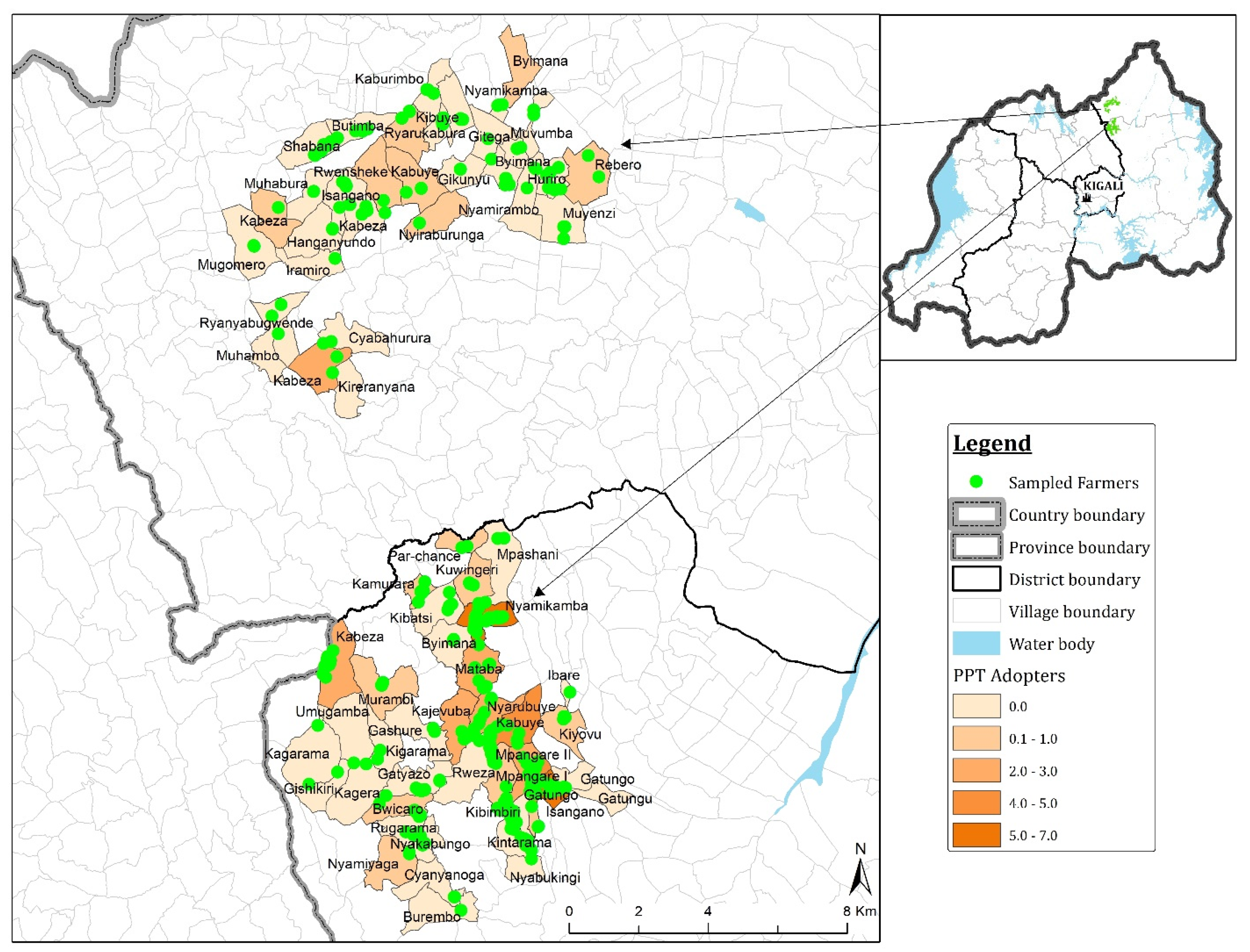
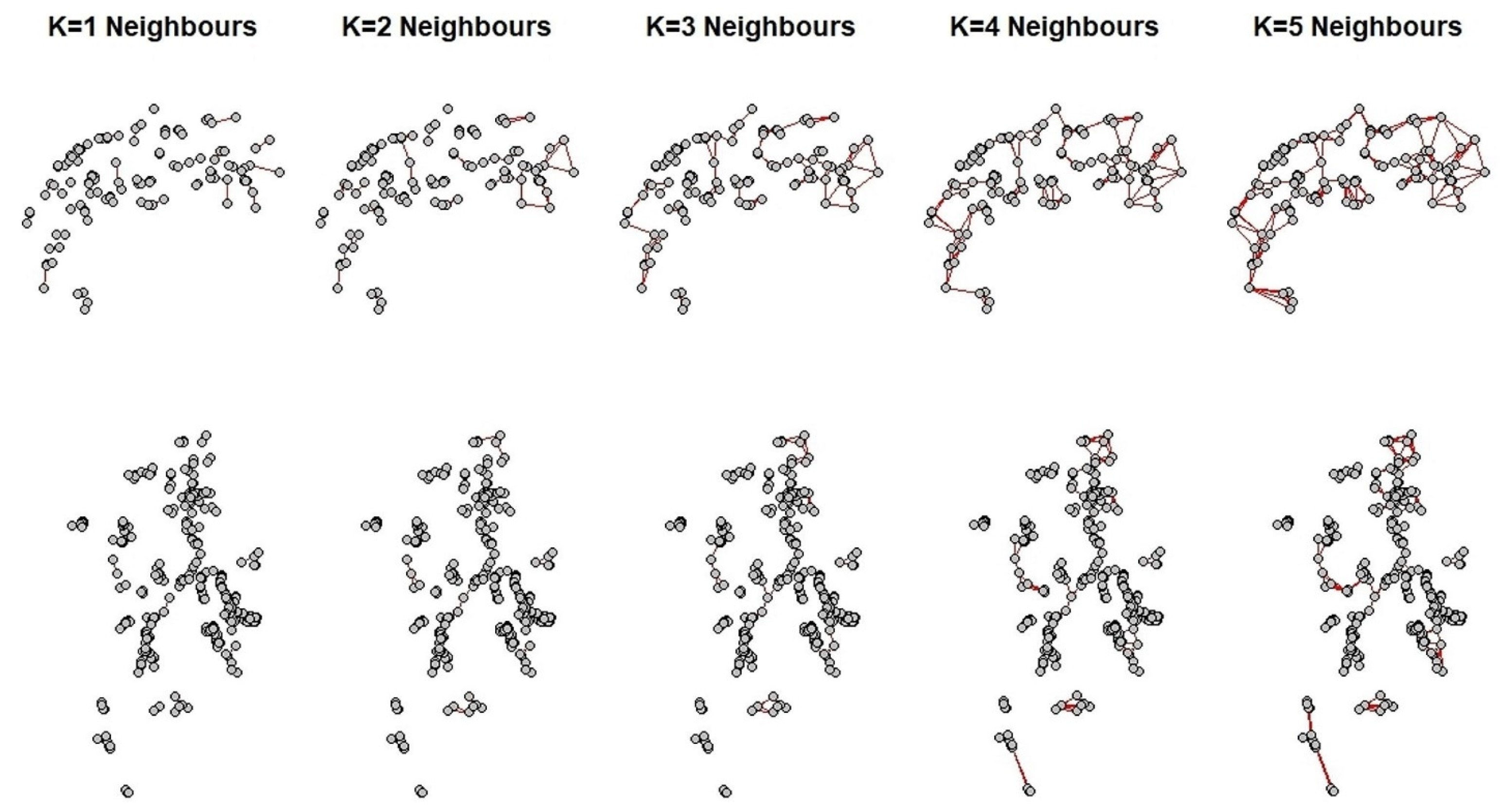
| K Value | Disjoint Regions | Distance (m) |
|---|---|---|
| 1 | 152 | 1189.90 |
| 2 | 62 | 1292.52 |
| 3 | 29 | 1308.05 |
| 4 | 16 | 1907.34 |
| 5 | 8 | 1962.38 |
| 6 | 8 | 2257.92 |
| 7 | 6 | 2307.59 |
| 8 | 6 | 2327.46 |
| 9 | 5 | 2671.36 |
| 10 | 4 | 2793.70 |
| Variables | Descriptions |
|---|---|
| Response Variable | |
| Soil Management | Use of grass strips or/and soil bunds as soil management practices (SMP) (No = 0, Yes = 1) |
| Explanatory Variables | |
| Age_hh_new | Age of the household head (years) |
| TLU_2 | Tropical livestock units (TLUs) |
| Soilfertil | Soil fertility (Good = 1, Medium = 2, Low = 3) |
| Plot_dist | Distance to the cultivated plot (in minutes of walking time) |
| Dist_ext | Distance to source of extension services (in minutes of walking time) |
| Altitude | Ground height measured in metres above sea level (m.a.s.l) |
| Localseed_ | Use of local seed (No = 0, Yes = 1) |
| Lnyield | Natural log of maize yield achieved by the household |
| Total_land | Total land owned (hectares) |
| Tot_cultla | Total cultivated land (hectares) |
| Ln_income | Natural log of household income |
| Hybrid_2 | Farmers use of hybrid maize (No = 0, Yes = 1) |
| DAP_2 | Use of diammonium phosphate fertiliser (No = 0, Yes = 1) |
| Insecticide | Used insecticide (No = 1, Yes = 1) |
| Hh_size2 | Total number of people in the household |
| credit_2 | Used credit in maize production (No = 0, Yes = 1) |
| Continue PPT | Farmer willingness to continue PPT (No = 0, Yes = 1). |
| numberofph | Number of mobile phones within the household (No = 0, One = 5 Two or more = 12) |
| educ_hh | Actual number of schooling years of household head. |
| herbicide | Used herbicides (No = 0, Yes = 1) |
| Hh_groups | Number of farmer groups the household belongs to |
| Extension | Access to extension services from relevant authorities (No = 0, Yes = 1). |
| training_2 | Household received training in PPT use (No = 0, Yes = 1). |
| Variables | Minimum | Maximum | Mean | Std. Deviation |
|---|---|---|---|---|
| Response Variable | ||||
| Soil Management | 0.00 | 1.00 | 0.83 | 0.37 |
| Explanatory Variable | Minimum | Maximum | Mean | Std. Deviation |
| Age of house head (years) | 22.00 | 86.00 | 47.66 | 11.83 |
| Total Livestock Units | 0.00 | 13.00 | 0.94 | 1.25 |
| Soil fertility status (Good = 1, Medium = 2, Low = 3) | 1.00 | 3.00 | 1.90 | 0.65 |
| Plot distance (minutes of walking time) | 1.00 | 90.00 | 16.22 | 17.82 |
| Distance to extension services (minutes of walking time) | 2.00 | 240.00 | 43.51 | 44.86 |
| Altitude (m.a.s.l.) | 1133.00 | 5047.00 | 1526.72 | 191.89 |
| Used local seed (No = 0, Yes = 1) | 0.00 | 1.00 | 0.32 | 0.47 |
| Natural log of yield | 3.30 | 9.10 | 6.11 | 1.40 |
| Total land owned (ha) | 0.02 | 14.82 | 2.07 | 2.49 |
| Total land cultivated (ha) | 0.04 | 4.59 | 1.05 | 1.12 |
| Natural log of household income | 8.58 | 12.75 | 10.84 | 0.94 |
| Used DAP fertiliser (No = 0, Yes = 1) | 0.00 | 1.00 | 0.31 | 0.46 |
| Used insecticide (No = 0, Yes = 1) | 0.00 | 1.00 | 0.26 | 0.44 |
| Used hybrid seed (No = 0, Yes = 1) | 0.00 | 1.00 | 0.72 | 0.45 |
| Household size (members) | 1.00 | 19.00 | 5.21 | 2.17 |
| Used credit (No = 0, Yes = 1) | 0.00 | 1.00 | 0.25 | 0.43 |
| Education level of household head (years) | 0.00 | 17.00 | 4.63 | 2.84 |
| Number of mobile phones in the household (No = 0, One = 5 Two or more = 12). | 0.00 | 12.00 | 5.87 | 4.84 |
| Used herbicides (No = 0, Yes = 1) | 0.00 | 1.00 | 0.03 | 0.16 |
| Number of farmer groups household belongs to (number) | 0.00 | 1.00 | 0.89 | 0.31 |
| Accessed training in PPT (No = 0, Yes = 1) | 0.00 | 1.00 | 0.40 | 0.49 |
| Accessed extension services (No = 0, Yes = 1) | 0.00 | 1.00 | 0.52 | 0.50 |
| Estimate | Std. Error | z Value | Pr(>|z|) | |
|---|---|---|---|---|
| (Intercept) | −0.215 | 0.636 | −0.339 | 0.735 |
| Age of house head (years) | 0.001 | 0.001 | 0.457 | 0.648 |
| Total Livestock Units | −0.016 | 0.013 | −1.274 | 0.203 |
| Soil fertility status (Good = 1, Medium = 2, Low = 3) | −0.002 | 0.024 | −0.078 | 0.938 |
| Plot distance (minutes of walking time) | 0.001 | 0.001 | 1.363 | 0.173 |
| Distance to extension services (minutes of walking time) | −0.001 | 0.000 | −1.328 | 0.184 |
| Altitude (m.a.s.l.) | 0.000 | 0.000 | 0.231 | 0.817 |
| Used local seed (No = 0, Yes = 1) | 0.105 | 0.047 | 2.224 | 0.026 ** |
| Natural log of yield | 0.034 | 0.012 | 2.891 | 0.004 *** |
| Total land owned (ha) | −0.035 | 0.012 | −2.865 | 0.004 *** |
| Total land cultivated (ha) | 0.097 | 0.027 | 3.523 | 0.000 *** |
| Natural log of household income | −0.045 | 0.018 | −2.516 | 0.012 ** |
| Used DAP fertiliser (No = 0, Yes = 1) | 0.055 | 0.038 | 1.458 | 0.145 |
| Used insecticide (No = 0, Yes = 1) | −0.104 | 0.039 | −2.622 | 0.009 *** |
| Used hybrid seed (No = 0, Yes = 1) | 0.130 | 0.049 | 2.662 | 0.008 *** |
| Household size (members) | 0.013 | 0.007 | 1.861 | 0.063 * |
| Used credit (No = 0, Yes = 1) | −0.049 | 0.037 | −1.338 | 0.181 |
| Education level of household head (years) | 0.008 | 0.006 | 1.327 | 0.185 |
| Number of mobile phones in the household (No = 0, One = 5, Two or more = 12). | 0.004 | 0.004 | 1.063 | 0.288 |
| Used herbicides (No = 0, Yes = 1) | 0.142 | 0.099 | 1.435 | 0.151 |
| Number of farmer groups household belongs to (number) | 0.119 | 0.051 | 2.336 | 0.019 ** |
| Accessed training in PPT (No = 0, Yes = 1) | −0.026 | 0.053 | −0.493 | 0.622 |
| Accessed extension services (No = 0, Yes = 1) | 0.038 | 0.050 | 0.766 | 0.444 |
| lag.Age_hh_new | 0.004 | 0.003 | 1.320 | 0.187 |
| lag.TLU_2 | −0.020 | 0.028 | −0.730 | 0.465 |
| lag.soilfertil | 0.091 | 0.054 | 1.681 | 0.093 * |
| lag.plot_dist | 0.005 | 0.002 | 2.922 | 0.003 *** |
| lag.dist_ext | −0.001 | 0.001 | −1.363 | 0.173 |
| lag.altitude | 0.000 | 0.000 | −0.358 | 0.720 |
| lag.localseed_ | 0.024 | 0.094 | 0.254 | 0.800 |
| lag.lnyield | 0.036 | 0.024 | 1.482 | 0.138 |
| lag.total_land | 0.006 | 0.025 | 0.238 | 0.812 |
| lag.tot_cultla | 0.007 | 0.052 | 0.127 | 0.899 |
| lag.ln_income | 0.015 | 0.041 | 0.368 | 0.713 |
| lag.DAP_2 | −0.052 | 0.083 | −0.626 | 0.531 |
| lag.insecticid | −0.141 | 0.083 | −1.698 | 0.090 * |
| lag.hybrid_2 | −0.076 | 0.101 | −0.746 | 0.456 |
| lag.hh_size2 | 0.012 | 0.017 | 0.708 | 0.479 |
| lag.credit_2 | −0.121 | 0.083 | −1.456 | 0.145 |
| lag.educ_hh | 0.004 | 0.012 | 0.311 | 0.756 |
| lag.numberofph | 0.018 | 0.009 | 2.109 | 0.035 * |
| lag.herbicide_ | 0.035 | 0.190 | 0.185 | 0.853 |
| lag.hh_groups | 0.023 | 0.110 | 0.226 | 0.821 |
| lag.training_2 | 0.033 | 0.109 | 0.304 | 0.761 |
| lag.extension_ | 0.012 | 0.106 | 0.112 | 0.911 |
| Rho: 0.14888, LR test value: 4.8641, p-value: 0.027421 Asymptotic standard error: 0.066296 z-value: 2.2457, p-value: 0.02472 Wald statistic: 5.0434, p-value: 0.02472 | ||||
| Log likelihood: −148.5598 for mixed model ML residual variance (sigma squared): 0.10521, (sigma: 0.32435) Number of observations: 504 Number of parameters estimated: 47 AIC: 391.12, (AIC for lm: 393.98) LM test for residual autocorrelation test value: 0.47136, p-value: 0.49236 | ||||
| Direct | Indirect | Total | |
|---|---|---|---|
| Age of house head (years) | 0.001 | 0.005 | 0.006 (−0.00189, 0.01326) |
| Total Livestock Units | −0.017 | −0.026 | −0.043 (−0.11397, 0.02686) |
| Soil fertility status (Good = 1, Medium = 2, Low = 3) | 0.000 | 0.105 | 0.105 (−0.02585, 0.23024) |
| Plot distance (minutes of walking time) | 0.001 | 0.006 | 0.008 (0.00326, 0.01213) |
| Distance to extension services (minutes of walking time) | −0.001 | −0.001 | −0.002 (−0.00338, −0.00012) |
| Altitude (m.a.s.l.) | 0.000 | 0.000 | −0.000 (−0.00050, 0.00040) |
| Used local seed (No = 0, Yes = 1) | 0.106 | 0.046 | 0.152 (−0.07572, 0.37378) |
| Natural log of yield | 0.035 | 0.047 | 0.082 (0.02863, 0.13919) |
| Total land owned (ha) | −0.035 | 0.001 | −0.035 (−0.09748, 0.02672) |
| Total land cultivated (ha) | 0.097 | 0.024 | 0.121 (−0.00012, 0.24929) |
| Natural log of household income | −0.045 | 0.010 | −0.035 (−0.13776, 0.06286) |
| Used DAP fertiliser (No = 0, Yes = 1) | 0.054 | −0.050 | 0.004 (−0.20882, 0.20769) |
| Used insecticide (No = 0, Yes = 1) | −0.107 | −0.180 | −0.288 (−0.49739, −0.08137) |
| Used hybrid seed (No = 0, Yes = 1) | 0.129 | −0.065 | 0.064 (−0.18604, 0.31258) |
| Household size (members) | 0.014 | 0.016 | 0.029 (−0.01350, 0.07277) |
| Used credit (No = 0, Yes = 1) | −0.053 | −0.148 | −0.201 (−0.42408, 0.00599) |
| Education level of household head (years) | 0.008 | 0.006 | 0.013 (−0.02050, 0.04441) |
| Number of mobile phones in the household (No = 0, One = 5 Two or more = 12). | 0.004 | 0.022 | 0.026 (0.00487, 0.04634) |
| Used herbicides (No = 0, Yes = 1) | 0.143 | 0.065 | 0.208 (−0.22190, 0.67516) |
| Number of farmer groups household belongs to (number) | 0.120 | 0.049 | 0.169 (−0.12826, 0.45474) |
| Accessed training in PPT (No = 0, Yes = 1) | −0.025 | 0.034 | 0.008 (−0.24039, 0.27499) |
| Accessed extension services (No = 0, Yes = 1) | 0.039 | 0.020 | 0.059 (−0.22102, 0.31780) |
Disclaimer/Publisher’s Note: The statements, opinions and data contained in all publications are solely those of the individual author(s) and contributor(s) and not of MDPI and/or the editor(s). MDPI and/or the editor(s) disclaim responsibility for any injury to people or property resulting from any ideas, methods, instructions or products referred to in the content. |
© 2024 by the authors. Licensee MDPI, Basel, Switzerland. This article is an open access article distributed under the terms and conditions of the Creative Commons Attribution (CC BY) license (https://creativecommons.org/licenses/by/4.0/).
Share and Cite
Kidoido, M.M.; Agboka, K.M.; Chidawanyika, F.; Hailu, G.; Belayneh, Y.; Mutyambai, D.M.; Owino, R.; Kassie, M.; Niassy, S. Spatial Spillover Effects of Smallholder Households’ Adoption Behaviour of Soil Management Practices Among Push–Pull Farmers in Rwanda. Sustainability 2024, 16, 10349. https://doi.org/10.3390/su162310349
Kidoido MM, Agboka KM, Chidawanyika F, Hailu G, Belayneh Y, Mutyambai DM, Owino R, Kassie M, Niassy S. Spatial Spillover Effects of Smallholder Households’ Adoption Behaviour of Soil Management Practices Among Push–Pull Farmers in Rwanda. Sustainability. 2024; 16(23):10349. https://doi.org/10.3390/su162310349
Chicago/Turabian StyleKidoido, Michael M., Komi Mensah Agboka, Frank Chidawanyika, Girma Hailu, Yeneneh Belayneh, Daniel Munyao Mutyambai, Rachel Owino, Menale Kassie, and Saliou Niassy. 2024. "Spatial Spillover Effects of Smallholder Households’ Adoption Behaviour of Soil Management Practices Among Push–Pull Farmers in Rwanda" Sustainability 16, no. 23: 10349. https://doi.org/10.3390/su162310349
APA StyleKidoido, M. M., Agboka, K. M., Chidawanyika, F., Hailu, G., Belayneh, Y., Mutyambai, D. M., Owino, R., Kassie, M., & Niassy, S. (2024). Spatial Spillover Effects of Smallholder Households’ Adoption Behaviour of Soil Management Practices Among Push–Pull Farmers in Rwanda. Sustainability, 16(23), 10349. https://doi.org/10.3390/su162310349






